We use and dispose of so many products (and plastic), we don’t even realize it. If you’re like me, once you go out into the world on your own, you use all the same products that your parents did when you lived at home. The products we use get ingrained in us and using them becomes more of a habit than a conscious choice. But there’s another way – you can easily swap out the plastic and disposable products you’ve used for years for sustainable eco-friendly products and no additional cost or inconvenience to your everyday life.
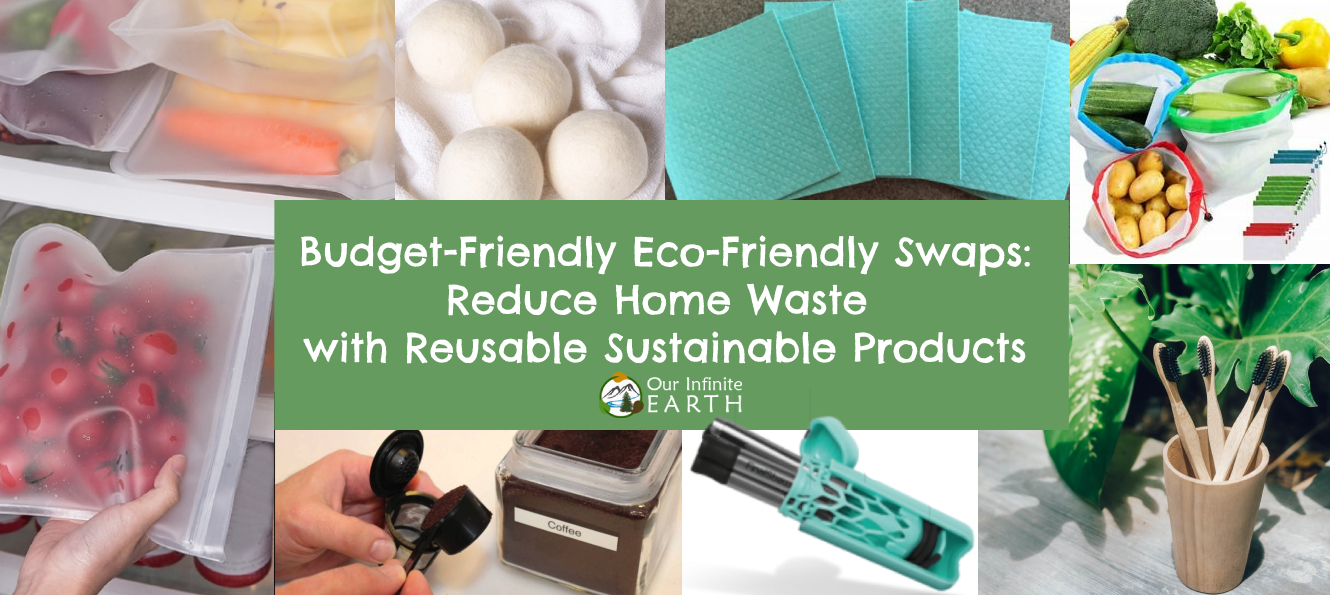
Even if you’re an avid recycle-er, it’s still better to use reusable products and reduce your waste, even if that waste were to be recycled – not everything you put into the recycle bin actually gets recycled! Plus it takes energy to recycle. Yes for sure, it’s way better than not, but what’s even better than recycling? Not creating waste!
I’m inspired by Lauren Singer who can fit all of the waste she generates in 4 years into one mason jar. I think this is incredible and something to aspire to, but also a bit impractical for my life and would probably require some lifestyle changes, which lets be honest, I’m not really willing to make. But there are still a lot of ways to reduce everyday household waste without getting too “hippy dippy” about it and still living a “normal” lifestyle.
So take a walk around your home and see if any of these eco-friendly sustainable replacements could fit into your everyday life and move you further along on the quest to reduce plastic and paper waste.
Kitchen
Plastic Sandwich Bags
Reusable Silicone Air Tight Sandwich Bags

I absolutely love these things and don’t know what I did without them. In attempts to cut down on my plastic waste, I use to use plastic sandwich or ziplock bags, then wash them out and use them again 3-4 time before throwing them out. But ultimately, I was still throwing away plastic and honestly never really thought to try to find a better solution. I thought I was doing my part as best I could by washing and reusing the plastic bag. Then my aunt sent me these reusable silicone sandwich bags for Christmas and my life was changed (ok may’e that’s a little dramatic), but these silicone reusable bags really are great!
They’re freezable, dishwasher-able, holds liquids, and have an air-tight seal. Just “zip” the plastic slider along the edge of the bag to close it completely. They come in a variety of sizes and can completely replace any use you have for plastic bags in a much more sustainable way.
Paper Towels
Swedish Dishcloths
This was a big one for me – how do you keep a clean house without paper towels? I use to use paper towels for just about everything – as napkins, for cleaning, covering dishes, while cooking etc. and then I’d always feel bad when I look in the trash and see a big pile of essentially paper.
Enter the Swedish dishcloth – part paper towel, part linen dish cloth, part sponge. These can be used for just about anything that you’d use a paper towel for, especially for any sort of cleaning. They’re super absorbent and also much tougher than a standard paper towel, so even better for scrubbing. Then once you’ve cleaned up the mess just throw it in the washer or dishwasher rather than the trash. They can be reused hundreds of times and can last over 9 months – that’s a lot of trees that would have been paper towels you’re saving, not mention the impact on your wallet! Plus once the dishcloth has come to the end of it’s life and it’s time to throw it away, it’s biodegradable because it’s made from natural, renewable, plant-based materials!
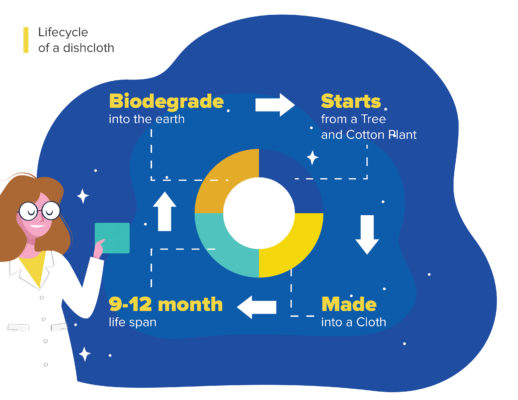
Ok fine, yes there are some particularly gross messes that you might not want to use the Swedish dishcloth for – I live with cats who sometimes miss the litter box and sometimes you just want to throw out everything that came in contact with that mess, and it might not be time to throw away a dishcloth just yet. In those few cases, then bamboo paper towels are the way to go. They still don’t solve the problem of creating waste like the dishcloth does, but at least bamboo is a much faster growing and more renewable resource than a tree, so they have less of an environmental impact.
Paper Napkins
Cloth Napkins
Paper napkins are a thing that parents use when the family sits down to a well balanced dinner, but in the real world, I don’t really have the time for that, so paper towels did the job just as well… but why? Why do we need to use a paper product just to blot your mouth after a meal or wipe off your hands? It’s another thing that I never even questioned because it’s just how things were done – you used some form of a napkin when you ate. And cloth napkins were always reserved for “fancy” meals like around the holidays when the whole family was together… but again, why? Why can’t you use cloth napkins all the time? There’s no reason not to – just grab a cloth napkin instead of a paper towel or napkin and when you’re done with it, throw it in with the laundry. You don’t need to iron it or make it a “fancy” thing – it’s just another way to be more eco-friendly and reduce the waste in your house.
Plastic Produce Bags At The Grocery Store
Reusable Mesh Produce Bags
Another reusable product that I really love and can’t believe I didn’t know of before. You know when you go to the grocery store and get some produce and there are the rollers of thin plastic bags that you can never open next to the vegetable and fruit stands? I always felt so guilty using those since it’s just so much plastic… and every person in the store uses them…. ugh. But you have to use them since the alternative is placing your nice clean food in the dirty shopping cart. Then you get home and the plastic goes into the trash/recycle – what a waste!

Then one year my aunt gave me these reusable mesh produce bags for Christmas and I couldn’t believe that I had never known there was such a great alternative! They’re so much better and so easy to use. Just take the produce bag to the store with you, fill it up, take it home, throw it in the washer if you want, and then do it again. No waste!
Paper/ Plastic Shopping Bags
Reusable Tote Shopping Bags
These have already caught on in many places in the country. In fact in some areas, there’s now a 10cent charge for paper/plastic bags as an incentive for people to use reusable tote bags instead. Yes it can be a little inconvenient to have to remember to bring your bags with you when you go to the store, but it really does have such an impact on the environment and is a much better solution.
Plastic/Paper Straws
The Final Straw: Collapsible Metal Straw
Another product that I really truly love. I really love straws – they’re just so much better to drink out of than just a regular ol’ cup. But again, I feel bad for the turtles that get them caught in their nose and the birds that choke on them. Many places had switched to using paper straws rather than plastic, which is good, but they always seem to fall apart and melt before you get to the end of your drink, they feel weird in your mouth, and ultimately, they still end up in the trash (even if they’re getting recycled or are biodegradable). Especially if you’re out a bar having a cocktail, it’s almost mandatory to use a straw… so what are you to do?
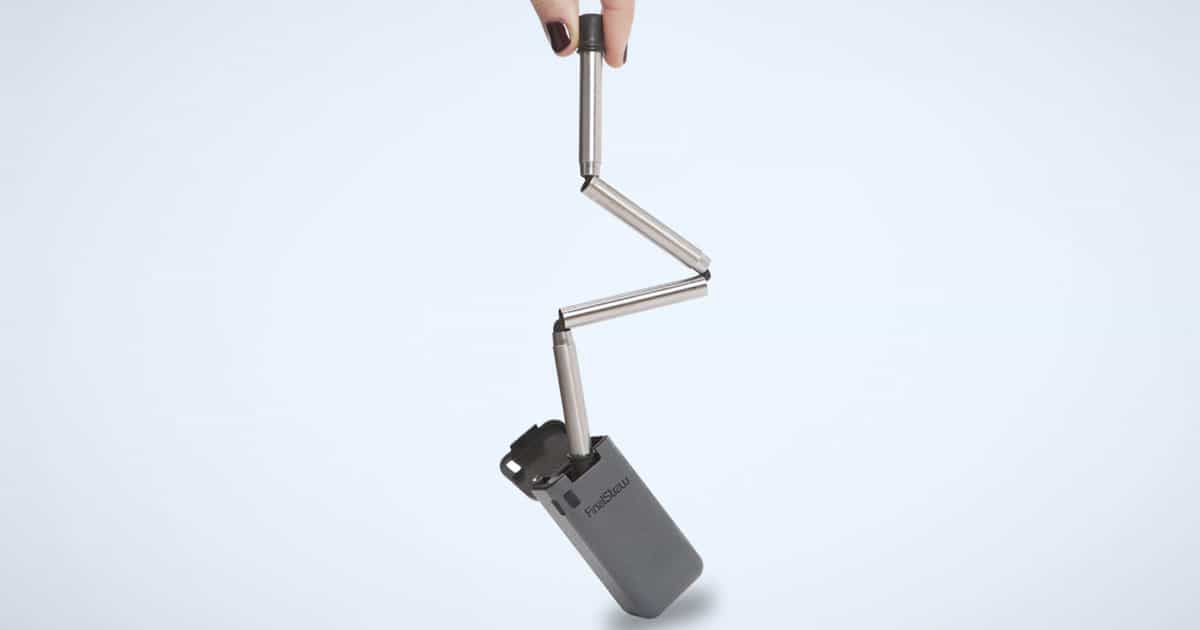
The Final Straw! It even has a cool name! There are lots of alternatives for straws these days, but this one is my favorite. This is a collapsible metal straw with a silicone center. It folds up into a little container that you can keep in your purse or pocket or put it on your key chain. Mine is literally always with me. Then when you take it out, you unfold it and look like a bad-ass wizard as the straw snaps together (I’ve literally had people tell me “that’s so cool”). It’s nice and soft and rubbery in your mouth and it even comes with a mini squeegee within the case for quick on-the-go cleaning. Then when you get home, just throw it in the dishwasher to clean it fully. This was my first switch to an eco-friendly product and I still am so happy with this purchase.
Disposable Teabags
Tea Infuser and Loose Leaf Tea
While tea bags themselves aren’t so bad (they’re biodegradable), it’s more the packaging that comes with tea bags that’s the problem. Here again we have plastic wrap and cardboard, which yes can be recycled, but still isn’t as good as no waste at all. Instead, switch to loose leaf tea and tea infusers. I like the cute ones that are shaped like little animals that hang onto the side of your cup 🙂 Loose leaf tea usually comes in tin containers and no plastic wrapping. Plus by using an infuser, there’s nothing being thrown away once your tea is done steeping. Just empty the infuser, put it in the dishwasher, and reuse it again.
Disposable Single Use Keurig Coffee Pods
Refillable Keurig Coffee Pods
Everyone loves Keurig coffee makers – these single serving coffee pods are so easy to use. Just pop it in, turn it on and ta-da coffee just for you. And you can make a hot new cup whenever you want another and even try out lots of different flavors. But what happens to that coffee pod once you’re done with it? It’s plastic filled with coffee grounds, so it goes into the trash. If you have even just one cup of coffee a day, these pods can quickly add up.

So why not follow the same habit and have the same coffee ritual, but use a refillable coffee pod instead? Fill it with your favorite coffee grounds and then pop it in the machine – it works just the same as the pre-filled pods. (You’ll probably want to fills the pods the night before or do a few of them at one time so that you’re not trying to do it when you’re groggy early in the morning).
Disposable Paper Coffee Cup
Reusable Coffee Cup
Staying on the coffee train – if your coffee ritual is to take it to go or to stop at your favorite coffee shop on your way to work, then you could probably use a reusable coffee cup. Fill it with coffee at home and take it to go or hand it to the barista at your favorite shop and the majority of the time, they’ll fill it up for you. They come in the same shape as the typical “to go” coffee cup so at a glance no one will really know the difference. Also if you’re super into Starbucks, there are ones that even have their logo on it too. Or if cold coffee or cold drinks are more your thing, then a reusable tumbler is the way to go.
Plastic Trash Bags
Biodegradable Trash Bags
Until we reach the levels of Lauren Singer and her ability to fit all of her trash for 4 years into one mason jar, trash is still going to happen. It’s a pretty inevidable part of life. So rather than putting your trash into those big plastic trash bags, which will sit in a landfill and take hundreds of years to decompse – instead, put your trash into a bag that’s actually biodegradable. It’s the same process for you, but a very different impact on the environment as a biodegradable trash bag will help to cut down on waste much more quickly.
Plastic Water Bottle
Reusable Water Bottle
At this point, I think this one is basically a no-brainer. Not to be condescending or anything, but we all know that plastic water bottles aren’t good. It takes 450 years for a plastic water bottle to decompose… or so we think since plastic hasn’t even been around for 450 years for us to test this.

Yes there are places in the world that don’t have fresh water supplies and in those places, they often use and need bottled water, which is unavoidable. So in those areas since drinkable water is a necessity and may not be available any other way, then plastic water bottles are sometimes the only option, and hopefully they’re getting recycled. But in areas where we do have potable water, there’s no reason to be using a plastic water bottle rather than a reusable one. This one even looks like a plastic bottle if you don’t want to stand out.
Just get a filter for your tap water if you’re worried about the quality of your tap water and then fill up your reusable bottle and take it with you if you think you’re going to want some water through out the day.
PS – aside from places like Flint MI and 3rd world countries, there are some documentaries about tap water and how companies have brain washed us through marketing to think that tap water isn’t clean or “pure” that are quite illuminating: Rotten (Season 2, Ep 3: Troubled Water) and Bottled Life, both on Netflix.
Bathroom
Plastic Toothbrush
Biodegradable Bamboo Toothbrush
Another thing you’ve probably never thought of (or at least I hadn’t). When you think of different types of toothbrushes, even when you talk with your dentist, you talk about the options for the harshness of the bristles, or if maybe you should try an electric toothbrush – but no one talks about what the toothbrush is made out of: PLASTIC! Big, hard, thick, not-biodegradable plastic. And that’s just how it is, that’s all that you’re going to see if you go to a pharmacy or grocery store and buy a toothbrush… but why? Why is it important that the thing that holds together the bristles (which is the important part that actually touches your teeth) be made out of plastic? It’s not! Who cares what the thing you’re using to manipulate the bristles is made out of as long as it does it’s job of holding onto the bristles.
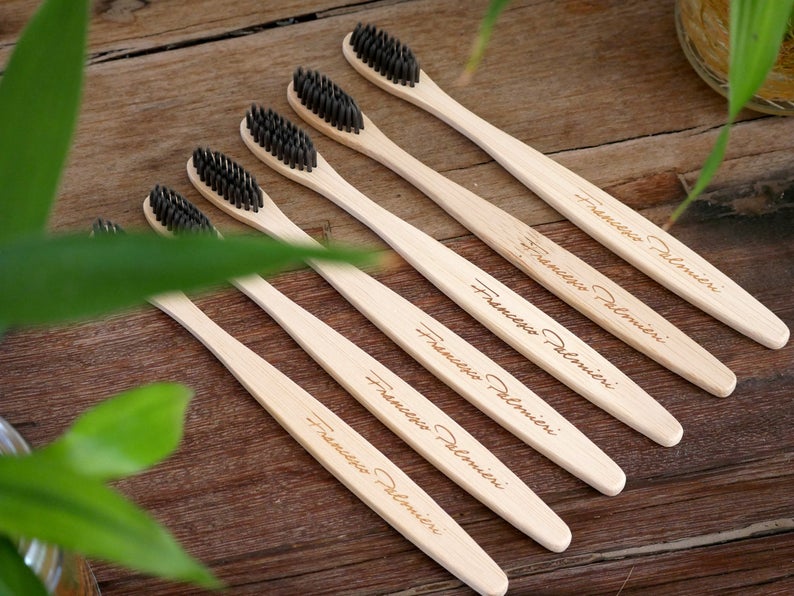
So stop using those big hard plastic toothbrushes that are never going to degrade once you throw them out and instead, switch to a biodegradable bamboo toothbrush, or one made out of wood or some other sort of biodegradable material. I’m partial to the bamboo ones since bamboo grows quickly and is fairly renewable as far as resources go – at least more so than a tree that would be cut down and used for wood.
There is a slight adjustment period once you start using these since it is a different texture in your mouth. Plastic is nice and sleek and smooth and bamboo isn’t and has rougher edges, but after about a week you get use to it and it’s really not bad at all.
And if you really wanna get “hippy dippy” about it, you can also switch to capsle toothpaste too, which avoids all the plastic packaging of regular toothpaste. This is a bit too far for me since I want my toothpaste to have flouride and haven’t yet found a capsle that does, but it’s still a good idea on the right track.
Shampoo & Conditioner in Plastic Bottles
Shampoo & Conditioner Bars
Shampoo and conditioner comes in so much plastic packaging! Each bottle is thick hard plastic and every option that you see at the pharmacy or grocery store has this same type of packaging – why? What you want is what’s inside the container, so why does it matter what the package that it comes in is made out of? It doesn’t. You can get the same quality shampoo and conditioner in a bar format and cut out the need for all the packaging. Shampoo and conditioner bars come in cardboard boxes (which can then be recycled), which reduces your waste and impact on the environment.
Sure it might feel a little weird at first using “bar soap” (even though it’s not soap) on your hair rather than a liquid, but it foams up just the same and gets the job done just the same, only without all of the big plastic bottles that are never going to degrade.
Body & Hand Soap in Plastic Containers
Mrs. Meyer’s Bar Soap
Same thing here as above – there’s no need for all of the plastic packaging when it comes to hand soap! There’s the connotation that liquid hand soap is “nicer” or “fancier” than bar soap – but why? And who cares – the job of the soap is to clean your hands and it can do that in liquid or bar format. As a bar, you’re reducing the waste of the plastic bottle packaging and instead switching to cardboard packaging, which is recyclable and biodegradable.
I’m also partial to Mrs. Meyer’s products as a brand since when it comes to ingredients, they’re almost exclusively plant-based and don’t use a lot of harmful chemicals an ingredients that can be harmful to the environment.
Plastic Q-Tip
Silicone Reusable Q-Tip
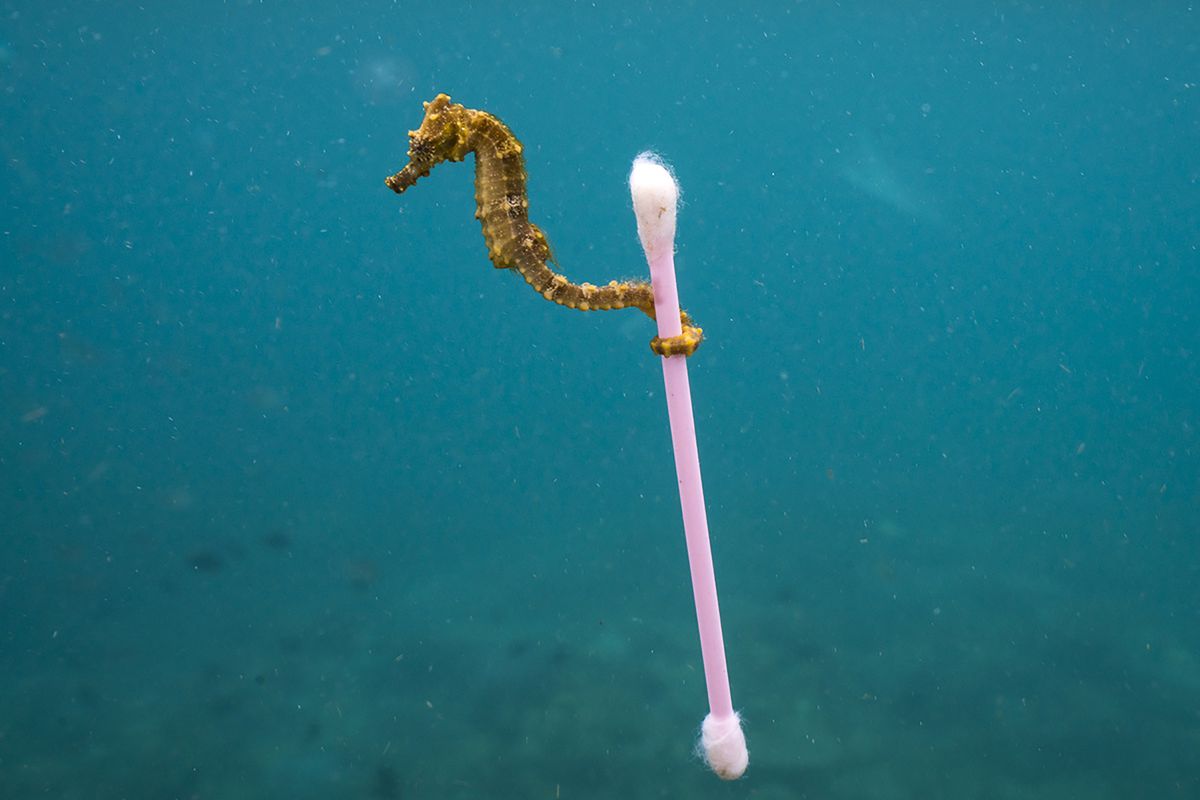
Roughly 1.5 billion cotton swabs are used by humans every day. I like having clean ears as much as the next person, but that’s a lot of plastic! And cottom swabs aren’t often something that gets recycled since it’s not a product that we’ve been programmed to put into the recycling bin (like bottles or other plastic containers).
So rather than using disposable plastic cotton swabs, switch to a silicone reusable Q-Tip instead! It get’s the job done just the safe but with less waste. These silicone swabs are easily washed with just soap and water and can be reused over and over again.
But if silicone swaps just don’t do it for you – you don’t want to clean them or just aren’t convinced, then the next best thing is bamboo Q-Tips. Basically the same exact things as the plastic version, only this is biodegratable and also bamboo is a pretty fast growing resource, so less environmental impact that if you were use wood.
Toilet Paper
Bamboo Toilet Paper
Some sort of disposable toliette paper product is really unavoidable. There’s not a hygenic way to have a reusable version of this product, so all we can really do is try to cut down on the resources that are being used to make it. With that, bamboo toilet paper is a good way to go. As I’ve talked about several times for other products in this article, bamboo is a fairly renewable resource – it grows very quickly and therefore can be replenished faster than a normal tree. So if we’re going to cut something down to make paper, I vote for bamboo first since it’s more sustainable.
Laundry
Disposable Dryer Sheets
Wool Dryer Balls
Tiny little things that we throw in with our clothes in the dryer to make our clothes soft and smell good. But what do they really do? Dryer sheets are meant to slowly release fabric softener while drying. But really they don’t do much of anything – they lubricate the fabric with a coating that prevents static and creates the illusion of softness. Dryer sheets can also contain harmful chemicals (some more toxic than kitchen cleaning products) that can potentially cause health problems to sensative people.

Even though most dryer sheets are bio-degradable, you won’t want these chemicals seeping into the ground (or sticking on your clothing). So instead, switch to wool dryer balls. This is a great chemical-free reusable alternative that still accomplishes the same goal: fluffy, soft, dried static-free clothing. Wool dryer balls will dry your clothes 15-20% faster, soften your clothing, and help reduce static. Each ball can last up to a year before needing to be replaced. If you’re willing to pay a little extra for cute-ness FriendSheep has some really adorable dryer balls that look like penguins, pigs, sheep, etc. (the image above).









